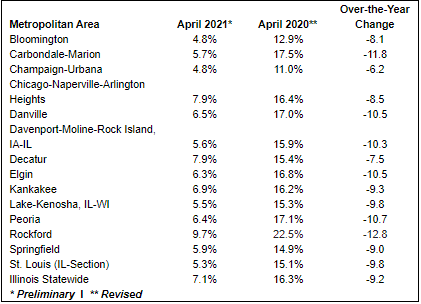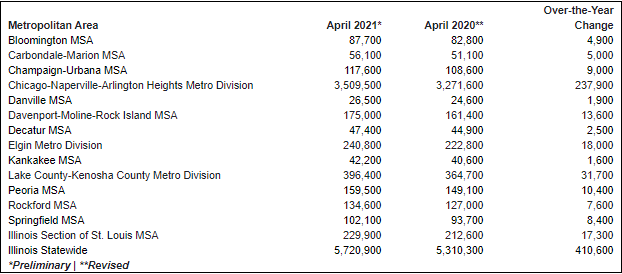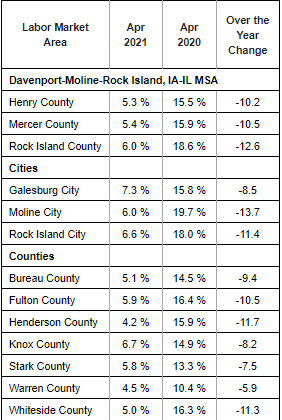SPRINGFIELD, ILLINOIS (May 28, 2021) — The number of non-farm jobs increased over-the-year in all fourteen Illinois metropolitan areas in April, according to preliminary data released today by the US Bureau of Labor Statistics (BLS) and the Illinois Department of Employment Security (IDES). The unemployment rate decreased over-the-year in all metro areas. The official, BLS approved sub-state unemployment rate and nonfarm jobs series begins in 1990.
“Decreased unemployment in all 102 counties compared to last spring is a critical component of Illinois’ pandemic recovery, and the administration will continue to deploy every available resource to ensure that this economic rebound is as widespread as possible,” said Deputy Governor Dan Hynes. “That said, COVID-19 is still with us, and the Department remains focused on supporting workers not yet able to rejoin the labor market through benefits as well as job-matching resources.”
The number of non-farm jobs increased in all fourteen Illinois metropolitan areas. The metro areas which had the largest over-the-year percentage increases in total non-farm jobs were the Carbondale-Marion MSA (+9.8%, +5,000), the Springfield MSA (+9.0%, +8,400), and the Lake County-Kenosha County, IL-WI Metropolitan Division (+8.7%, +31,700). Total nonfarm jobs in the Chicago-Naperville-Arlington Heights Metropolitan Division rose by +7.3%, +237,900.
Over-the-year, the unemployment rate decreased in all 14 metropolitan areas; the metro areas with the largest unemployment rate-decreases were the Rockford MSA (-12.8 points to 9.7%), the Carbondale-Marion MSA (-11.8 points to 5.7%), and the Peoria MSA (-10.7 points to 6.4%). The Chicago-Naperville-Arlington Heights Metropolitan Division unemployment rate fell -8.5 points to 7.9%. The unemployment rate also decreased over-the-year in all 102 counties.
Not-Seasonally-Adjusted Unemployment Rates

Total Nonfarm Jobs (Not Seasonally Adjusted) — April 2021

Not-Seasonally-Adjusted Unemployment Rates (percent) for Local Counties and Areas

Davenport-Moline-Rock Island, IA-IL MSA
The not-seasonally-adjusted unemployment rate decreased to 5.6 percent in April 2021 from 15.9 percent in April 2020. The last time the April rate was equal to or lower was in 2019, when it was 3.7 percent.
Total non-farm employment increased +13,600 compared to April 2020.
Manufacturing (-400), Wholesale Trade (-100), and Financial Activities (-100) sectors recorded employment declines compared to one year ago. The Leisure-Hospitality (+5,400), Educational-Health Services (+2,100), Retail Trade (+2,000) , Other Services (+1,500), and Construction (+1,200) sectors reported the largest payroll-gains.
The unemployment rate identifies those who are out of work and seeking employment. A person who exhausts benefits, or is ineligible, still will be reflected in the unemployment rate if they actively seek work.
Note: Monthly 2020 unemployment rates and total non-farm jobs for Illinois metro areas were revised in February and March 2021, as required by the US BLS. Comments and tables distributed for prior metro area news releases should be discarded as any records or historical analysis previously cited may no longer be valid. The official monthly unemployment rate series for metro areas, counties, and most cities begins in 1990. The official monthly non-farm jobs series for metro areas begins in 1990, and for non-metropolitan counties begins in 1999.










